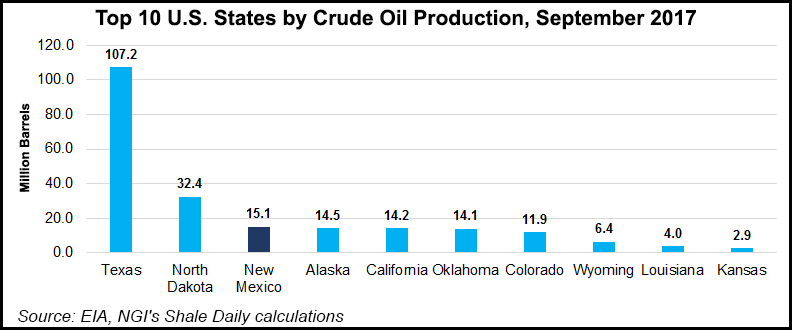Shale Daily | E&P | NGI All News Access | Permian Basin
Permian Lifts New Mexico to No. 3 in U.S. Oil Production Rankings
The latest data from the U.S. Energy Information Administration (EIA), albeit still not calendar year complete, shows New Mexico, whose southeastern corner has seen a surge in Permian Basin activity, climbing toward the nation’s No. 3 spot behind Texas and North Dakota for crude oil production.

Final EIA data for last September had New Mexico in the third position with more than 15.1 million bbl, ahead of No. 4 Alaska (14.4 million bbl), No. 5 California (14.1 million bbl) and No. 6 Oklahoma (14.05 million bbl)
More recent preliminary EIA data for October also indicated New Mexico oil output expanding to more than 16.3 million bbl. Alaska in October had tentative output of 15.7 million bbl, while Oklahoma had 15.2 million bbl to rank fourth and fifth.
The steady increase in monthly production is a result of a “surge in investment in the Permian,” Ryan Flynn, executive director of the New Mexico Oil and Gas Association (NMOGA), told reporters.
Large acquisitions are continuing throughout the Permian, but particularly in the Delaware sub-basin, which has spurred more activity, Flynn noted.
Another offshoot of the production surge has been a marked increase in tax revenues from oil and gas activities in New Mexico, producing the largest increase in the nation. The state in December reported fiscal year 2017 proceeds of $455 million from energy and mineral production on federal and Native American lands, an increase of $86.5 million year/year, according to the U.S. Department of Interior. Interior officials attributed the increase to higher oil prices, which increased to around $53/bbl at the end of September from $45/bbl in September 2016.
Early statistics from EIA for 2017 show that U.S. crude oil production increased to more than 9 million b/d based on production figures through September, resulting mostly from the continued robust growth in parts of the Permian Basin in Texas and New Mexico. Current predictions are for an overall increase in U.S. oil production this year of about 800,000 b/d.
© 2024 Natural Gas Intelligence. All rights reserved.
ISSN © 2577-9877 | ISSN © 2158-8023 |
